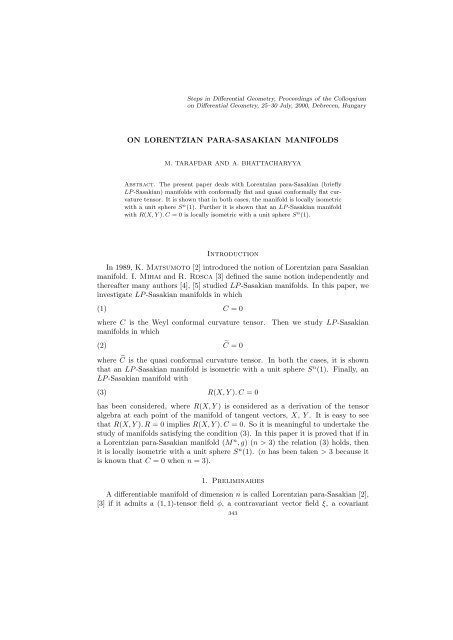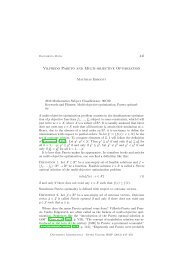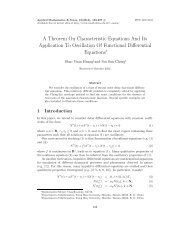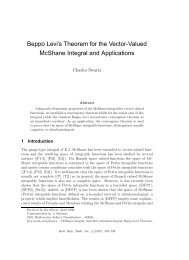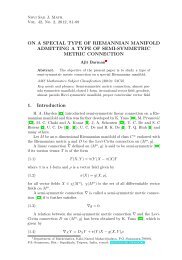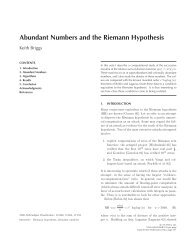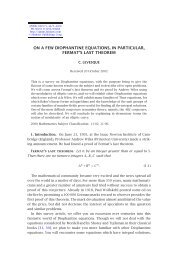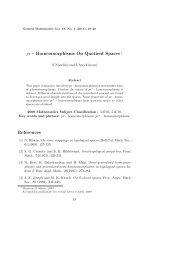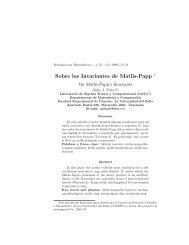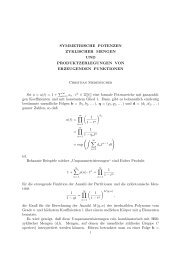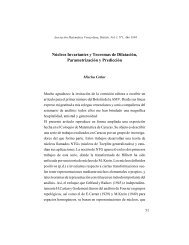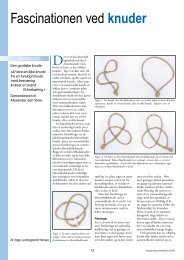ON LORENTZIAN PARA-SASAKIAN MANIFOLDS Introduction In ...
ON LORENTZIAN PARA-SASAKIAN MANIFOLDS Introduction In ...
ON LORENTZIAN PARA-SASAKIAN MANIFOLDS Introduction In ...
You also want an ePaper? Increase the reach of your titles
YUMPU automatically turns print PDFs into web optimized ePapers that Google loves.
Steps in Differential Geometry, Proceedings of the Colloquium<br />
on Differential Geometry, 25–30 July, 2000, Debrecen, Hungary<br />
<strong>ON</strong> <strong>LORENTZIAN</strong> <strong>PARA</strong>-<strong>SASAKIAN</strong> <strong>MANIFOLDS</strong><br />
M. TARAFDAR AND A. BHATTACHARYYA<br />
Abstract. The present paper deals with Lorentzian para-Sasakian (briefly<br />
LP -Sasakian) manifolds with conformally flat and quasi conformally flat curvature<br />
tensor. It is shown that in both cases, the manifold is locally isometric<br />
with a unit sphere S n (1). Further it is shown that an LP -Sasakian manifold<br />
with R(X, Y ). C = 0 is locally isometric with a unit sphere S n (1).<br />
<strong><strong>In</strong>troduction</strong><br />
<strong>In</strong> 1989, K. Matsumoto [2] introduced the notion of Lorentzian para Sasakian<br />
manifold. I. Mihai and R. Rosca [3] defined the same notion independently and<br />
thereafter many authors [4], [5] studied LP -Sasakian manifolds. <strong>In</strong> this paper, we<br />
investigate LP -Sasakian manifolds in which<br />
(1) C = 0<br />
where C is the Weyl conformal curvature tensor. Then we study LP -Sasakian<br />
manifolds in which<br />
(2)<br />
� C = 0<br />
where � C is the quasi conformal curvature tensor. <strong>In</strong> both the cases, it is shown<br />
that an LP -Sasakian manifold is isometric with a unit sphere S n (1). Finally, an<br />
LP -Sasakian manifold with<br />
(3) R(X, Y ). C = 0<br />
has been considered, where R(X, Y ) is considered as a derivation of the tensor<br />
algebra at each point of the manifold of tangent vectors, X, Y . It is easy to see<br />
that R(X, Y ). R = 0 implies R(X, Y ). C = 0. So it is meaningful to undertake the<br />
study of manifolds satisfying the condition (3). <strong>In</strong> this paper it is proved that if in<br />
a Lorentzian para-Sasakian manifold (M n , g) (n > 3) the relation (3) holds, then<br />
it is locally isometric with a unit sphere S n (1). (n has been taken > 3 because it<br />
is known that C = 0 when n = 3).<br />
1. Preliminaries<br />
A differentiable manifold of dimension n is called Lorentzian para-Sasakian [2],<br />
[3] if it admits a (1, 1)-tensor field φ, a contravariant vector field ξ, a covariant<br />
343
344 M. TARAFDAR AND A. BHATTACHARYYA<br />
vector field η and a Lorentzian metric g which satisfy<br />
(4)<br />
(5)<br />
(6)<br />
(7)<br />
(8)<br />
η(ξ) = −1<br />
φ 2 = I + η(X)ξ<br />
g(φX, φY ) = g(X, Y ) + η(X)η(Y )<br />
g(X, ξ) = η(X), ∇Xξ = φX<br />
(∇Xφ)Y = [g(X, Y ) + η(X)η(Y )]ξ + [X + η(X)ξ]η(Y )<br />
where ∇ denotes the operator of covariant differentiation with respect to the<br />
Lorentzian metric g.<br />
It can easily be seen that in an LP -Sasakian manifold the following relations<br />
hold:<br />
(9)<br />
(10)<br />
φξ = 0 η(φX) = 0<br />
rank φ = n − 1.<br />
Also, an LP -Sasakian manifold M is said to be η-Einstein if its Ricci tensor S<br />
is of the form<br />
(11) S(X, Y ) = ag(X, Y ) + bη(X)η(Y )<br />
for any vector fields X, Y where a, b are functions on M.<br />
Further, on such an LP -Sasakian manifold with (φ, η, ξ, g) structure, the following<br />
relations hold [4], [5]:<br />
(12)<br />
(13)<br />
(14)<br />
(15)<br />
(16)<br />
(17)<br />
g(R(X, Y )Z, ξ) = η(R(X, Y )Z) = g(Y, Z)η(X) − g(X, Z)η(Z)<br />
R(ξ, X)Y = g(X, Y )ξ − η(Y )X<br />
R(ξ, X)ξ = X + η(X)ξ<br />
R(X, Y )ξ = η(Y )X − η(X)Y<br />
S(X, ξ) = (n − 1)η(X)<br />
S(φX, φY ) = S(X, Y ) + (n − 1)η(X)η(Y )<br />
for any vector fields X, Y Z where R(X, Y )Z is the Riemannian curvature tensor.<br />
The above results will be used in the next sections.<br />
2. LP -Sasakian manifolds with C = 0<br />
The conformal curvature tensor C is defined as<br />
C(X, Y )Z = R(X, Y )Z − 1<br />
{g(Y, Z)QX − g(X, Z)QY<br />
n − 2<br />
r<br />
+S(Y, Z)X − S(X, Z)Y } +<br />
{g(Y, Z)X − g(X, Z)Y },<br />
(n − 1)(n − 2) (18)<br />
where<br />
S(X, Y ) = g(QX, Y ).
<strong>ON</strong> <strong>LORENTZIAN</strong> <strong>PARA</strong>-<strong>SASAKIAN</strong> <strong>MANIFOLDS</strong> 345<br />
Using (1) we get from (18)<br />
R(X, Y )Z =<br />
1<br />
{g(Y, Z)QX − g(X, Z)QY + S(Y, Z)X<br />
n − 2 (19)<br />
r<br />
−S(X, Z)Y } −<br />
{g(Y, Z)X − g(X, Z)Y }.<br />
(n − 1)(n − 2)<br />
Taking Z = ξ in (18) and using (7), (15) and (16), we find<br />
η(Y )X − η(X)Y =<br />
1<br />
n − 1<br />
{η(Y )QX − η(X)QY } + {η(Y )X − η(X)Y }<br />
n − 2 n − 2<br />
r<br />
−<br />
{η(Y )X − η(X)Y }.<br />
(n − 1)(n − 2)<br />
Taking Y = ξ and using (4) we get<br />
� � � �<br />
1<br />
r<br />
(20) QX = − 1 X + − 1 η(X)ξ.<br />
n − 1 n − 1<br />
Thus the manifold is η-Einstein.<br />
Contracting (20) we get<br />
(21) r = n(n − 1).<br />
Using (21) in (20) we find<br />
(22) QX = (n − 1)X.<br />
Putting (22) in (19) we get after a few steps<br />
(23) R(X, Y )Z = g(Y, Z)X − g(X, Y )Y.<br />
Thus a conformally flat LP -Sasakian manifold is of constant curvature. The<br />
value of this constant is +1. Hence we can state<br />
Theorem 1. A conformally flat LP -Sasakian manifold is locally isometric to a<br />
unit sphere S n (1).<br />
3. LP -Sasakian manifolds with � C = 0<br />
The quasi conformal curvature tensor � C is defined as<br />
(24) C(X, Y )Z = aR(X, Y )Z + b{S(Y, Z)X − S(X, Z)Y + g(Y, Z)QX<br />
−g(X, Z)QY } − r<br />
� �<br />
a<br />
+ 2b {g(Y, Z)X − g(X, Z)Y }<br />
n n − 1<br />
where a, b are constants such that ab �= 0 and<br />
Using (2), we find from (24)<br />
S(Y, Z) = g(QY, Z).<br />
R(X, Y )Z = − b<br />
{S(Y, Z)X − S(X, Z)Y + g(Y, Z)QX<br />
a (25)<br />
−g(X, Z)QY } + r<br />
� �<br />
a<br />
+ 2b {g(Y, Z)X − g(X, Z)Y }.<br />
n n − 1
346 M. TARAFDAR AND A. BHATTACHARYYA<br />
Taking Z = ξ in (18) and using (7), (15) and (16), we get<br />
η(Y )X − η(X)Y = − b<br />
{η(Y )QX − η(X)QY }<br />
a (26)<br />
� � �<br />
r a<br />
+ 2b −<br />
an n − 1 b<br />
�<br />
(n − 1) {η(Y )X − η(X)Y }.<br />
a<br />
Taking Y = ξ and applying (4) we have<br />
QX =<br />
� � �<br />
r a<br />
+ 2b − (n − 1) −<br />
bn n − 1 a<br />
(27)<br />
�<br />
X<br />
b<br />
� � �<br />
r a<br />
+<br />
+ 2b −<br />
bn n − 1 a<br />
�<br />
− 2(n − 1) η(X)ξ.<br />
b<br />
Contracting (27), we get after a few steps<br />
(28) r = n(n − 1).<br />
Using (28) in (27), we get<br />
(29) QX = (n − 1)X.<br />
Finally, using (29), we find from (25)<br />
Thus we can state<br />
R(X, Y )Z = g(Y, Z)X − g(X, Z)Y.<br />
Theorem 2. A quasi conformally flat LP -Sasakian manifold is locally isometric<br />
with a unit sphere S n (1).<br />
4. LP -Sasakian manifolds satisfying R(X, Y ).C=0<br />
Using (7), (13) and (16) we find from (18)<br />
η(C(X, Y )Z) = 1<br />
� � �<br />
r<br />
(30)<br />
− 1 {g(Y, Z)η(X)<br />
n − 2 n − 1<br />
−g(X, Z)η(Y )} − {S(Y, Z)η(X) − S(X, Z)η(Y )}<br />
Putting Z = ξ in (30) and using (7), (16) we get<br />
(31) η(C(X, Y )ξ) = 0.<br />
Again, taking X = ξ in (30), we get<br />
�<br />
1<br />
(32) η(C(ξ, Y )Z) = {S(Y, Z) + (n − 1)η(Y )η(Z)}<br />
n − 2<br />
� �<br />
�<br />
r<br />
− − 1 {g(Y, Z) + η(Y )η(Z)} .<br />
n − 1<br />
�<br />
.
Now<br />
(33)<br />
(34)<br />
<strong>ON</strong> <strong>LORENTZIAN</strong> <strong>PARA</strong>-<strong>SASAKIAN</strong> <strong>MANIFOLDS</strong> 347<br />
(R(X, Y )C)(U, V )W = R(X, Y )C(U, V )W − C(R(X, Y )U, V )W<br />
Using (3), we find from above<br />
−C(U, R)(X, Y )V )W − C(U, V )R(X, Y )W.<br />
g[R(ξ, Y )C(U, V )W, ξ] − g[C(R(ξ, Y )U, V )W, ξ]<br />
Using (7) and (13) we get<br />
where<br />
−g[C(U, R(ξ, Y )V )W, ξ] − g[C(U, V )R(ξ, Y )W, ξ] = 0.<br />
−‘C(U, V, W, Y ) − η(Y )η(C(U, V )W ) − G(Y, U)η(C(ξ, V )W )<br />
+η(U)η(C(Y, V )W ) − g(Y, V )η(C(U, ξ)W ) + η(V )η(C(U, Y )W )<br />
−g(Y, W )η(C(U, V )ξ) + η(W )η(C(U, V )Y ) = 0,<br />
Putting U = Y in (34) we find<br />
(35)<br />
‘C(U, V, W, Y ) = g(C(U, V )W, Y ).<br />
−‘C(U, V, W, U) − η(U)η(C(U, V )W ) + η(U)η(C(U, V )W )<br />
+η(V )η(C(U, U)W ) + η(W )η(C(U, V )U) − g(U, U)η(C(ξ, V )W )<br />
−g(U, V )η(C(U, ξ)W ) − g(U, W )η(C(U, V )ξ) = 0.<br />
Let {ei : i = 1, . . . , n} be an orthonormal basis of the tangent space at any point,<br />
then the sum for 1 ≤ i ≤ n of the relations (35) for U = ei gives<br />
(1 − n)η(C(ξ, V )W ) = 0<br />
(36) η(C(ξ, V )W ) = 0 as n > 3.<br />
(37)<br />
Using (31) and (36), (34) takes the form<br />
−‘C(U, V, W, Y ) − η(Y )η(C(U, V )W ) + η(U)η(C(Y, V )W )<br />
+η(V )η(C(U, Y )W ) + η(W )η(C(U, V )Y ) = 0.<br />
Using (30) in (37) we get<br />
� � �<br />
1 r<br />
(38) −‘C(U, V, W, Y ) + η(W )<br />
− 1 {η(U)g(V, Y )<br />
n − 2 n − 1<br />
�<br />
−η(V )g(U, Y )} − {η(U)S(V, Y ) − η(V )S(U, Y )}<br />
<strong>In</strong> virtue of (36), (32) reduces to<br />
�<br />
r<br />
(39) S(Y, Z) =<br />
n − 1 1<br />
�<br />
g(Y, Z) +<br />
Using (39), (37) reduces to<br />
(40) −‘C(U, V, W, Y ) = 0,<br />
� �<br />
r<br />
− n η(Y )η(Z).<br />
n − 1<br />
= 0.
348 M. TARAFDAR AND A. BHATTACHARYYA<br />
i.e.<br />
(41) C(U, V )W = 0.<br />
Hence the manifold is conformally flat. Using Theorem 1, we state<br />
Theorem 3. If in an LP -Sasakian manifold M n (n > 3) the relation R(X, Y ). C = 0<br />
holds, then it is locally isometric with a unit sphere S n (1).<br />
For a conformally symmetric Riemannian manifold [1], we have ∇C = 0. Hence<br />
for such a manifold R(X, Y ). C = 0 holds. Thus we have the following corollary of<br />
the above theorem:<br />
Corollary 1. A conformally symmetric LP -Sasakian manifold M n (n > 3) is<br />
locally isometric with a unit sphere S n (1).<br />
References<br />
[1] Chaki, M.C. and Gupta, B., On Conformally Symmetric Spaces, <strong>In</strong>dian J. Math., 5, 1963,<br />
113–122.<br />
[2] Matsumoto, K., On Lorentzian paracontact manifolds, Bull. Of Yamagata Univ. Nat. Sci.,<br />
Vol. 12, No. 2, 1989, pp. 151–156.<br />
[3] Mihai, I. and Rosca, R., On Lorentzian P -Sasakian manifolds, Classical Analysis, World<br />
Scientific Publi., Singapore, 1992, pp. 155–169.<br />
[4] Matsumoto, K. and Mihai, I., On a certain transformation in a Lorentzian para-Sasakian<br />
manifold, Tensor, N.S., Vol. 47, 1988, pp. 189–197.<br />
[5] Mihai, I. A.A. Shaikh and Uday Chand De, On Lorentzian para-Sasakian Manifolds.<br />
M. Tarafdar and A. Bhattachharyya, Department of Pure Mathematics, University<br />
of Calcutta, 35, Ballygunge Circular Road, Calcutta: 700019, <strong>In</strong>dia<br />
E-mail address: manjusha@cubmb.ernet.in


